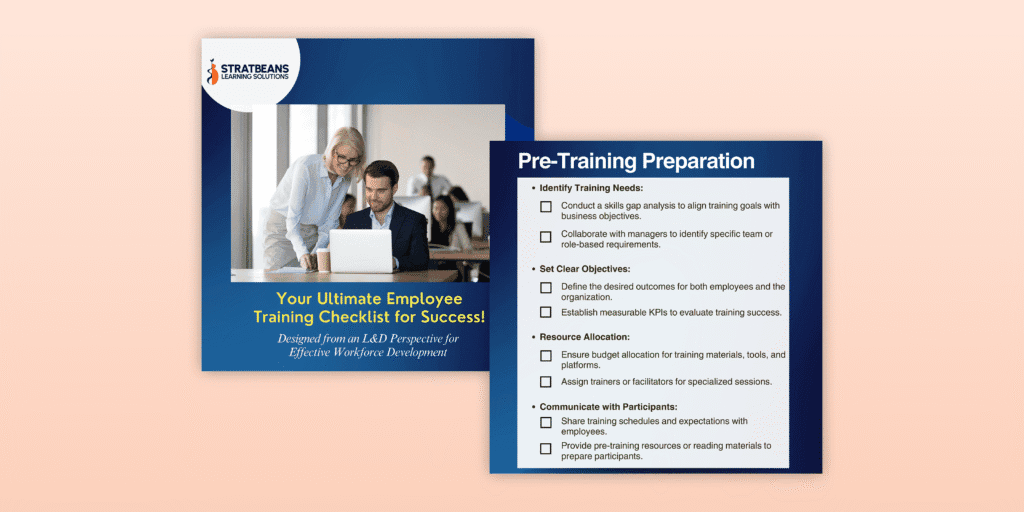Comprehensive Employee Training Checklist for Enhanced Performance and Safety
A well-designed employee training programme is more than just onboarding; it’s a holistic roadmap to foster long-term success, professional growth, and readiness for high-stakes environments. By using training checklists at every phase (from onboarding to advanced role-specific training), organisations can create a safe work environment, uphold company culture, and drive customer satisfaction.

Action Plans and Training Goals
A robust plan begins with action plans that highlight training goals, ensuring alignment with broader goals and legal requirements. Whether you’re developing a safety training checklist or a customer service training checklist, your focus should be on:
Smooth transition into new roles
Adherence to key policies
Ongoing skill development
Setting completion dates keeps training progress visible and encourages commitment to learning.
Key elements:
Training Materials: Manuals, presentations, and policy documents for both job-specific and general sessions.
Employee Handbook: Outlines performance expectations, compliance requirements, and administrative tasks.
Onboarding Checklist: Confirms each step of onboarding, covering safety, communication protocols, and role mastery.
By integrating training checklists throughout, you facilitate a structured plan that incorporates initial training and ongoing feedback.
Training Process and Development Policy
A complete training process should cover communication techniques, protective equipment usage, and interactive methods to improve learning outcomes.
Development Policy:
Provides clarity on training efforts and industry trends.
Ensures training checklists (onboarding, safety, compliance, leadership) remain consistent and updated.
Training Schedule:
Organise sessions on product knowledge, company overview, and corporate training.
Tailor content to department-specific needs.
Training Checklists:
Ensure role-based clarity (service training, protective equipment, safety, etc.).
Revisit them regularly to maintain a learning culture.
Compliance training is mandatory in many cases—covering hazardous materials, OSHA standards, or leadership training.
Ensuring a Safe Work Environment and Emergency Preparedness
Workplace safety must be prioritised through proactive training.
Emergency Procedures: Include evacuation drills in training to ensure preparedness.
Protective Equipment: Train employees on correct usage, especially in industries like construction.
Hazard Communication: Essential for both retail and corporate settings.
These measures reduce workplace risks and reinforce a culture of safety.
Role-Specific Elements and Expert Guidance
Role-specific training addresses unique responsibilities for different positions.
Customer-Facing Roles:
Customer Service Training Checklist helps employees handle interactions and improve satisfaction.
Sales associates benefit from product and delivery method training for onboarding success.
Leadership Roles:
Require specialised leadership training covering evaluation methods, performance reviews, and engagement strategies.
Company Culture and Employee Engagement
Strong company culture drives employee engagement and motivation.
Encourage learning through online courses, refresher training, and structured learning paths.
Use techniques like active listening, feedback sessions, and communication drills.
Reinforce corporate standards and onboarding updates to maintain alignment with KPIs.
Comprehensive Training Schedule and Resources
To ensure effectiveness, training should follow a structured schedule and use the right resources.
Preparation:
Define objectives (choose the right checklist: onboarding, safety, leadership).
Identify the audience (management, front-line, or specialised roles).
Assess needs through surveys and evaluation forms.
Choose delivery methods (on-the-job, workshops, or online).
Development:
Create accessible manuals, presentations, and checklists.
Use real-world scenarios and role-play to enhance learning.
Conducting Sessions:
Schedule multiple slots for flexibility.
Use engagement strategies (Q&A, interactive exercises).
Track attendance and participation.
Post-Training Activities:
Assess knowledge retention with evaluations.
Collect feedback for improvement.
Provide follow-up support like refresher modules.
Continuous Improvement:
Regularly review training effectiveness.
Update content based on new industry trends.
Promote lifelong learning to sustain growth.
Conclusion
A comprehensive employee training checklist ensures employees meet performance standards, comply with safety regulations, and remain aligned with company goals.
By integrating leadership, compliance, and role-specific checklists into your training programme, organisations can achieve higher productivity, stronger employee engagement, and long-term business success.
With structured policies, dedicated training spaces, and consistent evaluation, your workforce will gain the confidence, knowledge, and skills needed to thrive in today’s high-stakes environments.